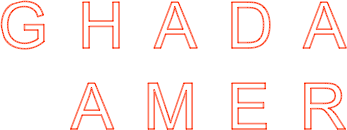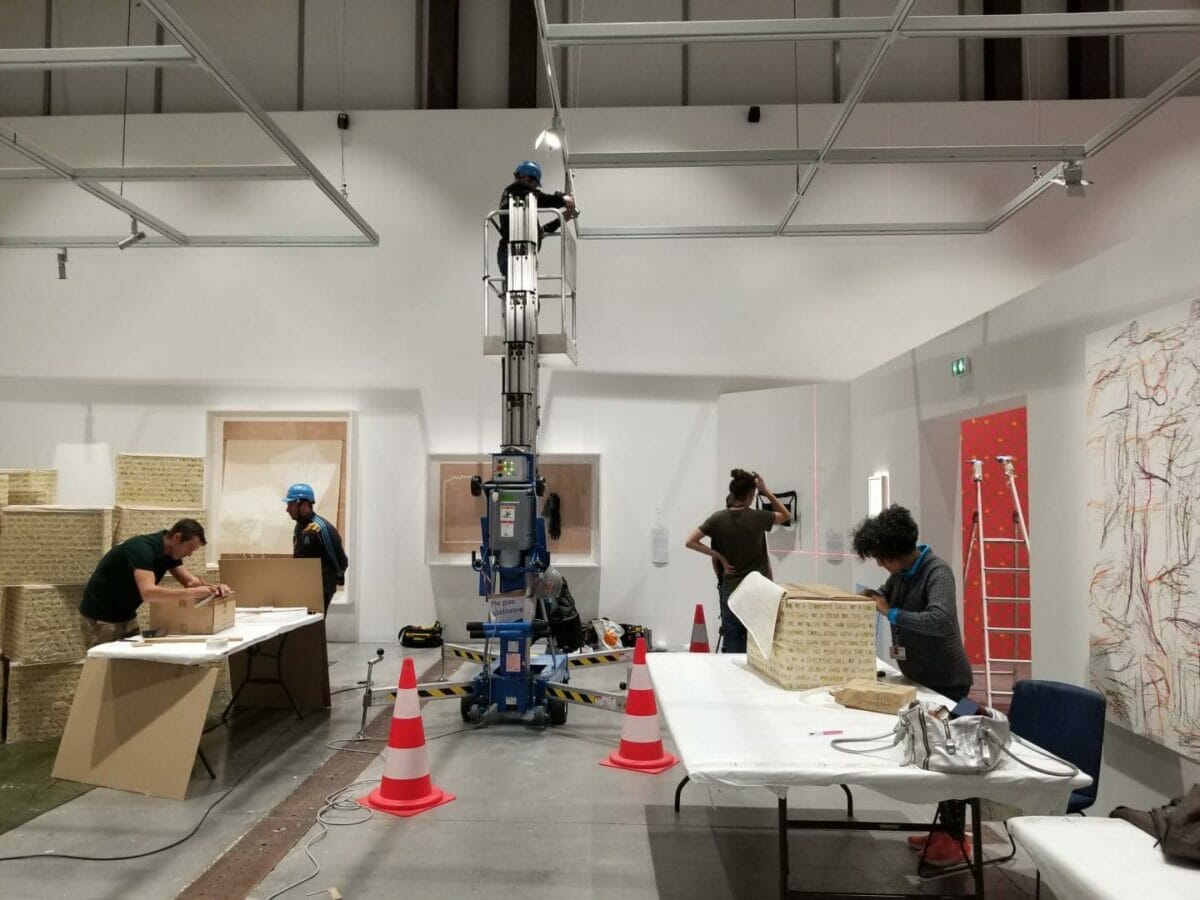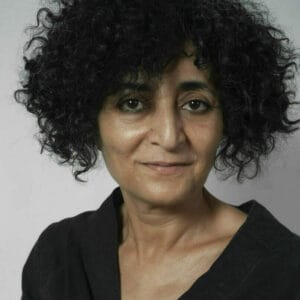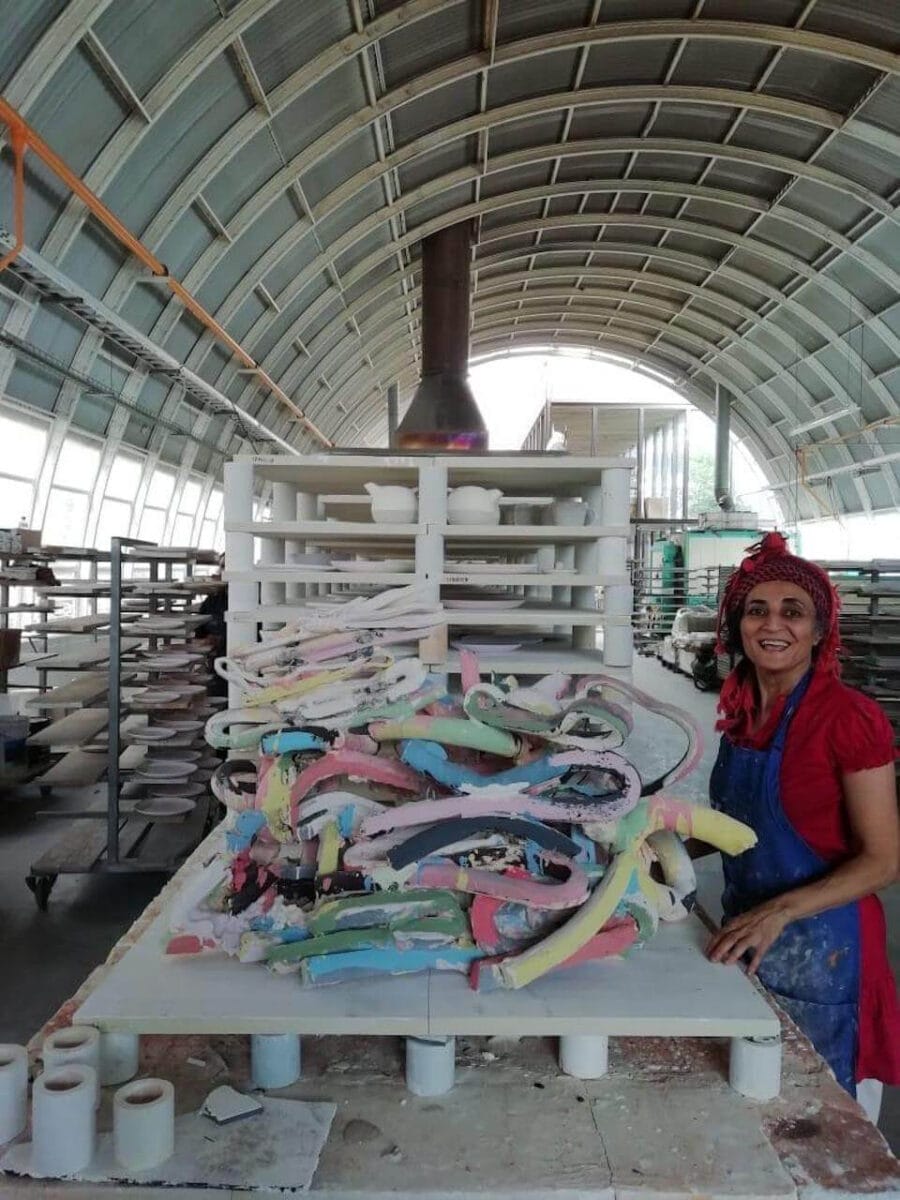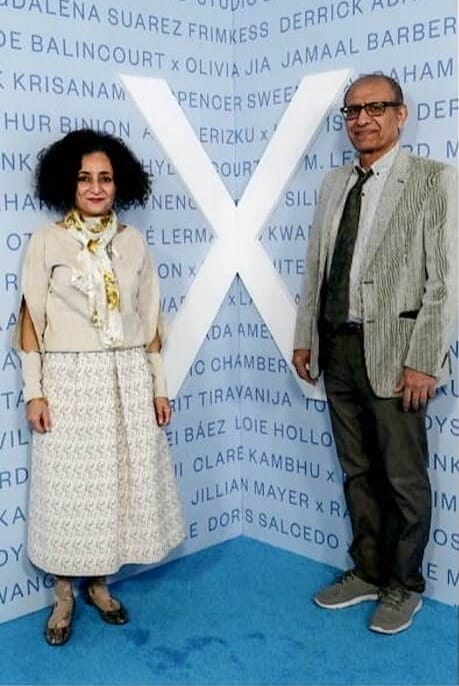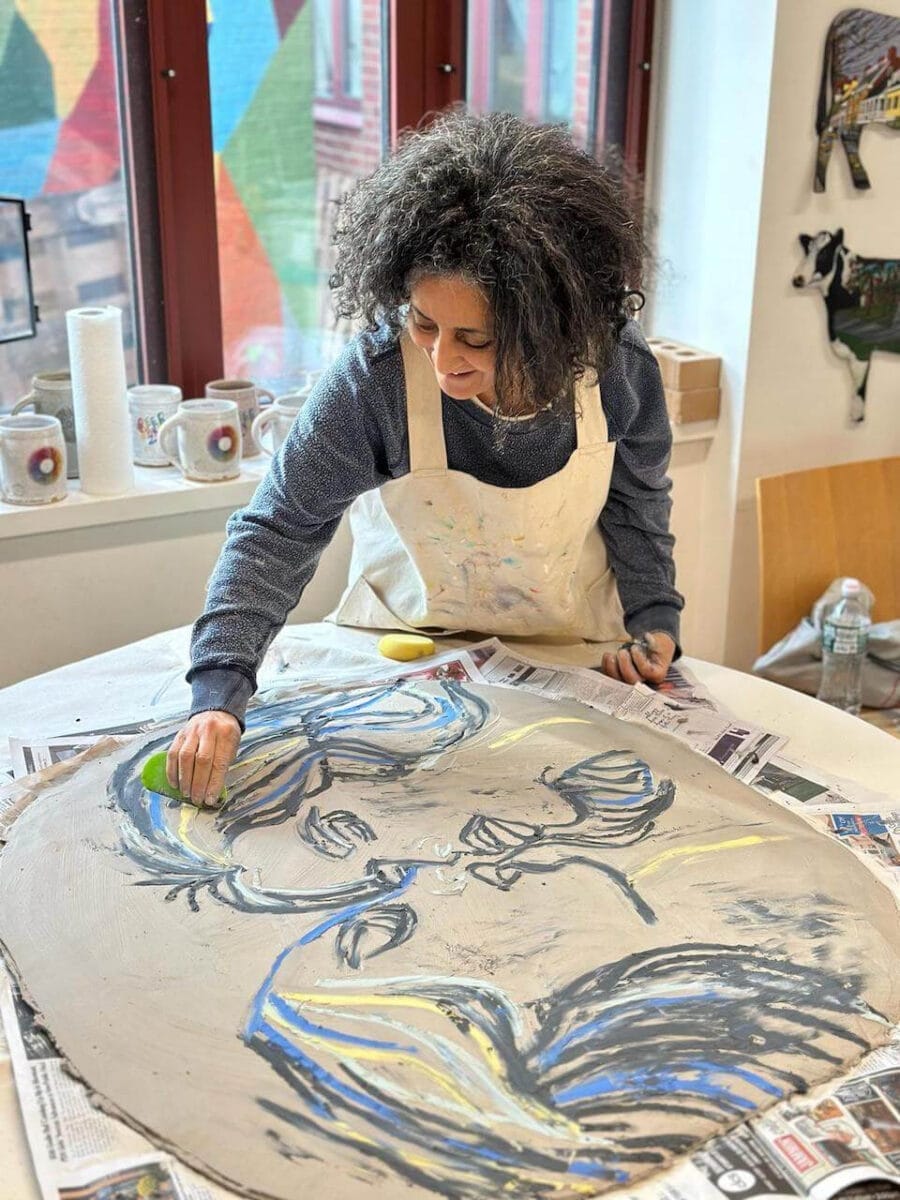The first French retrospective devoted to Ghada Amer will take place in Marseille. How did this project come about?
Hélia Paukner Ghada Amer is a well-known artist. She has an international career and her work has already been the subject of retrospectives in Rome and New York, but never in France – even though she was trained in this country, has lived here, is fluent in French, gained her French nationality in 2021, and is very attached to France. There was therefore a clear historiographical gap to fill. At the suggestion of Philippe Dagen, the Mucem wanted to remedy this. Ghada Amer’s Mediterranean and international career fits perfectly with the museum’s scientific and cultural remit, as does her social commitment.
Philippe Dagen This proposal was itself born of conversations in the artist’s studio over several visits, where I was increasingly aware of the intensity of the works that were accumulating there, and, I think I can say, of a friendly understanding between myself and the artist that has continued to grow. On my return from New York, I spoke about it with the president of the Mucem, Jean François Chougnet, and quickly understood that he shared my admiration for Ghada Amer.
This retrospective is presented in three parts and in three different locations in Marseille: how is the visit route organised?
H.P. The three parts (…) are quite complementary and address different themes: intercultural dialogue in Ghada Amer, East الغرب – – الشرق– West at the Mucem, feminist engagement in Ghada Amer, Witches and Bitches at the Frac, and more recent developments in Amer’s sculptural practice in Ghada Amer, Sculptor at the Vieille Charité. Finally, to complete this itinerary and further back to the Journées du Patrimoine on 17 September, we must mention the gardens of Fort Saint-Jean where a garden-sculpture has been set up for the entire duration of the exhibition.
From a more anecdotal point of view, Ghada Amer’s life is a story of journey. She was born in Egypt, trained in France and lives in the United States. In a way, these three stages can be found in the exhibition. The title of the Mucem section is in Arabic, the title of the Frac section in English, and the title of the Vieille Charité section in French.
Ph.D. To which I would only add that the participation of several institutions is in itself a sign of the oeuvre’s impact.
At the Mucem, the focus will be on the artist’s multiple cultures between East and West.
H.P. Yes, this is the first time that an exhibition has questioned the way in which the artist’s culture of origin and her chosen culture(s) intermingle or clash in her work. The aim is not to develop speculative points of view on Islam, religious prescriptions, racism or American politics in the Middle East, but rather to show Amer’s multiple artistic reactions when confronted with these issues at different moments in her life.
This is therefore the most personally charged part of the retrospective, and we were keen to include the artist’s words in the labels of the works presented.
The result is a virulent critique of prejudices and a renewed invitation to learn more about the cultures of the Near and Middle East – through, for example, the installations Private Rooms and Encyclopedia of Pleasure in which Ghada Amer studies certain fundamental Arabic texts.
It is also about women, between East and West.
H.P.Yes, Ghada Amer’s starting point is her own quest for identity: “A modern woman between Egypt, Europe, and the United States … but who am I?” Her answers are the expression of a deep aversion to any kind of prescription such as those expressed through dress standards, too often reduced to the issue of the veil. For Ghada Amer, the essential message is: “My body, my choice” regarding the freedom to veil or not. And to unveil oneself or not. For her, this freedom is also the freedom to paint a nude. At the Mucem, we will see, for example, a reinterpretation of Ingres’ The Turkish Bath, where the nude holds a privileged position: it is a militant act on the question of the representation of the female body, but also a postcolonial reappropriation of the stereotyped imagery of Orientalism.
Ghada Amer’s other hobbyhorse is stereotypes and the ignorance of the other. In the photos of the series I ♥ Paris, Ghada Amer, the artist Ladan S. Naderi, and one of their friends pose in full-face veils in various tourist locations in Paris in 1990. The aim was to assert the presence of Middle Eastern artists on the Parisian contemporary art scene, but also and above all to denounce the stereotypes that the West associates with Muslim women: no, a Muslim woman is not necessarily veiled; no, a veiled woman is not necessarily submissive; no, she is not synonymous with threat either. In the exhibition, we have therefore compared these images with other historical stereotypes, including those surrounding the Eastern woman fantasised in postcards from the colonial period.
The part presented at the Frac is called “Ghada Amer, Witches and Bitches” – two recurring motifs in her work?
H.P. These are figures that serve to denigrate women, but which feminists have reclaimed as symbols of struggle. Ghada Amer began to question the female body through sewing patterns and the question of dress standards. Then in 1991–92, in order to critique the objectifying view that men can have of the female body, she took images from pornographic magazines and embroidered them on her canvases. This is the basis of her work. Beyond a critique of pornography, we end up with a manifesto for a woman’s right to pleasure and fulfilment, erotic fulfilment being also a symbol of general fulfilment. When Ghada Amer draws, embroiders, paints or sculpts women kissing and making love, it is also her pleasure as a painter that is expressed. Her freedom. The freedom to draw the female body.
Ph.D. This point is essential. Denouncing the trade in the female body as practised by the entertainment and advertising industries is obviously the starting point. But Ghada Amer goes much further: the women she brings to life are, so to speak, the heroines of their freedom and enjoyment, as she herself is in drawing and painting them. She is a woman artist and paints female nudes after so many centuries of female nudes painted by male painters.
H.P. The part presented at the Frac also addresses the question of the place of women in the history of art. When she was a student in the late 1980s, Ghada Amer was denied access to the painting course because women painters had very little chance of a career. So she took up embroidery. Not to celebrate the art of embroidery, but to do painting, to conquer the medium of painting little by little. This is why she works a lot on the visible threads and colours, like a “painter” with “his” brushes.
Through her paintings, she takes a stand against the male ‘masters’ of 20th-century painting. There are many works in which she refers directly to painters she admires (Josef Albers, Sol LeWitt, and Claude Monet), and takes her place alongside them. In this way, she challenges male supremacy in art history.
Ph.D. In the past and present of art, it must be restated that the works of women artists have a much lower financial value in the art market than those of their colleagues of the other sex. There is no need to ask why. I could quote a well-known Parisian gallery owner who proudly said twenty years ago that he would never exhibit women artists… He has since changed his mind. I could also quote many French artists who were no less contemptuous while claiming to be avant-garde and revolutionary.
Ghada Amer has more recently turned her attention to the medium of sculpture, which will be the focus of the third part of the exhibition, presented in the chapel of the Centre de la Vieille Charité.
H.P. Ghada Amer has been interested in three-dimensionality since the 1990s, creating installations and garden-sculptures. But it was only later, in the 2010s, that she took up bronze and ceramics. It is these recent developments that can be seen in the chapel of la Vieille Charité.
The ceramic works are abstract and colourful. They have a very pictorial character: one sees gestures, almost brushstrokes, a pure pleasure in material and colour, reminiscent of abstract expressionism.
The three large-format bronzes, all three new, are figurative sculptures: Ghada Amer has transposed the pin-up motifs she is used to into sculpture. But it is a completely new relationship to space, volume, and monumentality that is being initiated here. The baroque setting of the chapel of la Vieille Charité wonderfully highlights this evolution.
Ph.D. Ghada Amer’s abstract ceramics are, for me, concretions of chromatic and bodily enjoyment. They are as much dances as sculptures.
On a personal level, what was your main discovery while working on this project?
H.P. I believe that, during these three years of collaboration, Ghada Amer has passed on to me some of her emancipator’s energy… But she has also allowed me to decentre my gaze anew. Until recently, I saw her work through the prism of my own cultural background. Pin-ups, for example, are common in our visual world. But when I went to Egypt for a few days and talked about Ghada Amer’s work with people around her, I truly discovered the radical nature of her artistic activity and the courage it implied. It is a powerful act to paint a nude in a context where the female body and sexuality are taboo. This awareness was intellectually and personally very moving.
Ph.D. No doubt, like Hélia, I was able to better measure what energy, what endurance, and what courage it took to resist so many prejudices, explicit or implicit. And to never give in, but, on the contrary, to continue to move forward, even in headwinds.
